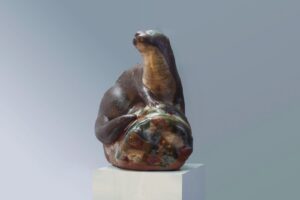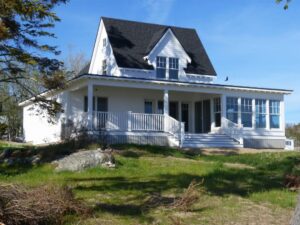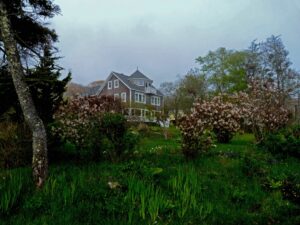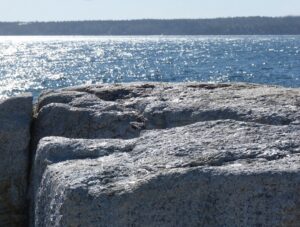 |
| Photo by Alif Assis on Unsplash |
 |
| Photo by Mackenzie Andersen on Unsplash |
I compose my blog by discovering the story as it unfolds, as I am doing now. I don’t know what the story is going to be until it says so. Dive in, and suddenly the story is in an ocean, coming in with the tide, influenced by the cycles of the moon.
These days, humanity must take leaps of faith. We are in an era of great shared uncertainty and unknowingness. scary, but creative. Some of you may be facing the possibility of losing the things that have become your rootedness. I have already done that. We lost our property in which our production studio and retail gallery was located along with our home. Since we lost our property. I have been following a road without GPS or cell phone, just letting the road lead, but keeping my internal direction focused on the way back to a new business home, not a house, a home. Not just one but many because it takes a village, to produce a line of designs as large as ours.

We also need a headquarters, especially important for creating the community. Recently a perfect space has become available, a space calls to be the new headquarters of Andersen Design, but for now we don’t have a plan for how to get it. It seems like it should be ours and that we should receive community support of the sort we could not find before when we lost our property. The owner told us that because we showed interest before it was on the market, we can negotiate a buy directly with her.
The fate of our historical property gives reason to support us now in attaining the old On Board property on Boothbay Road in Edgecomb, but only for those who value the culture that was once the Boothbay Region over the culture that is erasing our history, no where more evident than at our old homestead, although the Boothbay roundabout is viable competition for that title as a landscape placed in the middle of Boothbay’s formerly unobstructed main throughway, so that all can enjoy driving around it.
For years our idea has been to reinvent Andersen Design’s production as a series of independently owned smaller slip-casting studios with which we would establish independent contractor working relationships. Each studio could focus on specific pieces since different categories within our line call for individualized skills in making them.

The Andersen Design brand would be recapitalized and set up as a higher profile internet venue specializing in our work and the work of curated line of American Designer Craftsmen. Our brand has the history for that, impossible to fake.
The brand would be a connecting community for the network of studios which would also enjoy a high degree of self sovereignty, a challenging balance to achieve but an invigorating one. It is right for the future in a multiplicity of ways, not the least of which are in the emerging indicators that the grip that centralized authority has held over everything since the seventies is poised to disperse into more diversified cultural organization – that’s what I’m talking about! Now is the time to walk the talk, with a little help from our friends.
Recently, I approached Habitat for Humanity with the idea that they could fiscally sponsor Andersen Design in a mutual project to build working studios. When we were trying to save our property, we were rejected for fiscal sponsorship by the high NYC board of the major fiscal sponsor for the arts. The high board took an exceptionally long time to decide. Some of its members must have been for us but I will never know which is which, because in a contemporary wealth redistribution economy the actions of individual members of the board are opaque to the public. The public interacts only with the middle bureaucratic layer. The reason given for our rejection as a social enterprise was because I used the word “production” in the application, which the high board claimed, means one is only in it for the money.
Any 501 (3) C nonprofit can fiscally sponsor a private enterprise as a social enterprise, Andersen Design is historically recognized in our field. I believe that if we were fiscally sponsored, enabling Andersen Design to apply for grants, we have a strong chance of raising the funds we need.
I sent the proposal to all the Habitat For Humanity organizations in Maine but none responded. Such a relationship can benefit any non-profit organization operating as builders because we could use grant funding to hire the organization to build working spaces attached to a home, or stand alone. The idea is small working spaces, best suited for production as an art form and also for the new terms of existence since corona virus.
Tony Hansen, genius creator of Digital Fire ceramic making application, is on the same page as our concept with the email he sent titled Imagine if you had everything for production at home during Covid-19 . He costs that part for you. Perfect!

The old homestead and gardens of Andersen Design have been bulldozed over by one of Boothbay’s new developers and replaced with a building unrelated to anything. In a village of historical houses with front porches and front doors, there now sits a structure in the center of town, without a front door to be seen.
Andersen Design has always influenced its environment. As the first ceramic studio on the peninsula we instigated a cluster industry. Today we have intellectual property assets strong enough to be a contender for the direction the Peninsula is headed, a counter to becoming an exclusively upper end wealth culture. That might happen anyway but the Peninsula will surely become a wealth culture megalopolis if no alternate movement sets in. This would be a great loss because this Peninsula has its own unique character which deserves to be preserved.

The fate of our former property should be a siren call to every one who knows, loves and cares about the unique cultural community that Boothbay was for many decades, but It is not the only siren song filling the air waves of this locality.
Today, I took a break to check out the farmers market on the Commons at the Center of Boothbay.
Since the roundabout was constructed in route 27, the road round about the Commons had been made into a two way street, which I entered looking for parking for the Farmers Market on the Commons. There is a new large parking lot on the side of the road across from the Commons, but it looked full so I drove further on to check out the parking situation in the smaller parking lot located on the other side of the road toward the end of the Commons.
I was halted in my course suddenly and without fore warning when the two way street abruptly became a one way street. I could go no further. Traffic was backing up behind me but, fortunately, immediately behind me were motorcycles which could more easily maneuver so that I could back up into the parking lot across from the Commons. When I returned and left the parking lot I decided to look for an exit by driving up the hill and around the bend, where I could see another empty parking lot. There were no identifying or directional signs but I found an exit on to the road round about the Commons.
At that intersection is the only sign to be found in the entire configuration, excepting the One Way road sign I had previously encountered. The sign is a stop sign, but not your ordinary Department of Transportation stop sign, it is a designer stop sign. Of Course! What to expect from a town that places a landscape in the middle of a main road for no particular reason?
I took the Back River Road home. The transition from the main throughway to Back River Road was once a four way stop. It was framed as a reason why we needed to build the roundabout. The four way stop is governed by a rule of law that every driver knows, but it was said that some drivers sped through without stopping, and therefore it was very dangerous and had to be replaced.
When I went to make the turn on the new roadway there was heavy traffic travelling on the main throughway. When the four way stop was off to the side of the road, traffic on the main road was not a factor when making the transition to Back River. The new configuration has a turning lane but no rule of law governing the turn.
Another vehicle was trying to turn onto the main throughway. Like those primitive cave men who drive vehicles made out of stones, we hand signalled each other to concur on who would go first.
If a traffic signal were placed at the more complex configuration where Country Club Road meets Route 27, it would provide interruptions in the flow of traffic at the transition onto Back River Road. That is no longer an option because a traffic light where it is needed could potentially back traffic up around the new landscape situated in the middle of Route 27 by the Commons. If traffic gets backed up there no one can get through from any direction, especially with the one way roundabout around the Commons transformed into a two way dead end street (or entrance to the country club).
Later in reflection, I realized that the missing signs, combined with the fact of the designer stop sign, lead to the conclusory assumption that the country club has taken over most of the road round about the Commons. What appeared to be a two way street around the Commons is actually a two way dead end street, or else an entrance to the country club.
A roundabout was built in a random location, in strategic proximity to the country club, and an existing road around the Commons was partitioned and truncated. Some day the two way entrance will be fully identified as the entrance to the country club and the one way section that is now the entrance to the Commons should just be made into a full parking lot for the Commons. I hope there is an independent landscaper hired for the Commons to distinguish it from the country club with its gardening style that lines flowers up in rows like soldiers in uniform. Contrasting to that should be some lyrical gardens for the Commons. The military flowers have taken over everything in the surrounding area, including our Town Office, and why not? Without the support of our Town leaders we wouldn’t have new landscaping in the middle of the road. What other town has that?
All of our local leadership supported the round about. Wendy Wolf, then head of the Boothbay Harbor selectmen and the Joint Economic Development Council of Boothbay and Boothbay Harbor said she supported the roundabout adding only that it was not a referendum on Paul Coulombe, as if there was nothing else that anyone could be concerned about, such as infrastructure design and functionality, or expense .
The round about is indeed a referendum on Paul Coulombe. The supporting evidence is an incredibly dysfunctional road design. According the the DOT agreement, the design of the road was the private developer’s decision.
DOT Cooperative Agreement, pg 3
1. Proiect Design:The Developer has procured a contract with a qualified engineering firm to design the Project in accordance with specifications approved by MaineDOT (the “Design Contract”). The Design Contract also includes all necessary title research, right of way mapping services and preparation of transactional documents to properly identify existing conditions, property impacts, and all parties having ownership or financial interests in the affected abutting properties, and to effectively transfer the necessary property rights to the Developer and, in turn, to MaineDOT. The Developer shall ensure that the following standards and expectations are met:
It is written in the DOT Cooperative Agreement that PGC5 LLC submitted a design for the Boothbay roundabout for approval by the Maine Department of Transportation. It is witnessed by Dale Doughty, Director of the Maine Department of Transportation on April 17, 2017.

Architecture communicates the cultural identity of places. Boothbay is a town under siege though no one says that outloud. When my family moved here in 1952, Boothbay was a mixture of cultures, the local year round community, the artists community, and the seasonal community. There were always wealthy people who blended in with the rest of the community, without dominating. Boothbay has lost that quality. Our community leaders have a thinly veiled end goal of economic development, which is nothing more and nothing less than increasing property values. This mirrors what has been happening at the national level. In recent years the mega economy has decreased investments in research and production in order to increase investments in financial assets. In such a culture that means devaluation of the work ethic and of the meaning that work brings to life, above and beyond earning a living.
According the the realtor website our former property is now one of the highest valued properties in the village and Ocean Point.
However, the property tax assessment is now about half of what it was when the old homestead stood, in need of repairs but fundamentally an elegant and historical building to which my father had added an attachment that seamlessly continued the lines of the structure. The developer took down my father’s hand built stone wall and put in a more institutionally correct stone wall before he gave up on landscaping. A cumbersome structure now sits atop land bulldozed over into a chaotic heap of happenstance.
In the spring the ground cover took over the otherwise barren hillside looking like it was running down the hill, about to consume the structure that begs to be torn down and replaced with something fitting to the village. Maybe the tax assessor agrees since the tax assessment took a large drop when the property was bulldozed over and another when the new one was constructed.
According to the internet it costs only $8000.00 to $15000.00 to take down a structure but then one must finance a new one.
If we can find the means to acquire the old On Board property in Edgecomb, not only will we add something to the community that celebrates the value of work, craftsmanship, and design, but we will preserve the historical character of our region in the property. History is our stakeholder.
I’ll be back with the tide. You can follow me by clicking here.


Pingback: Andersen Design